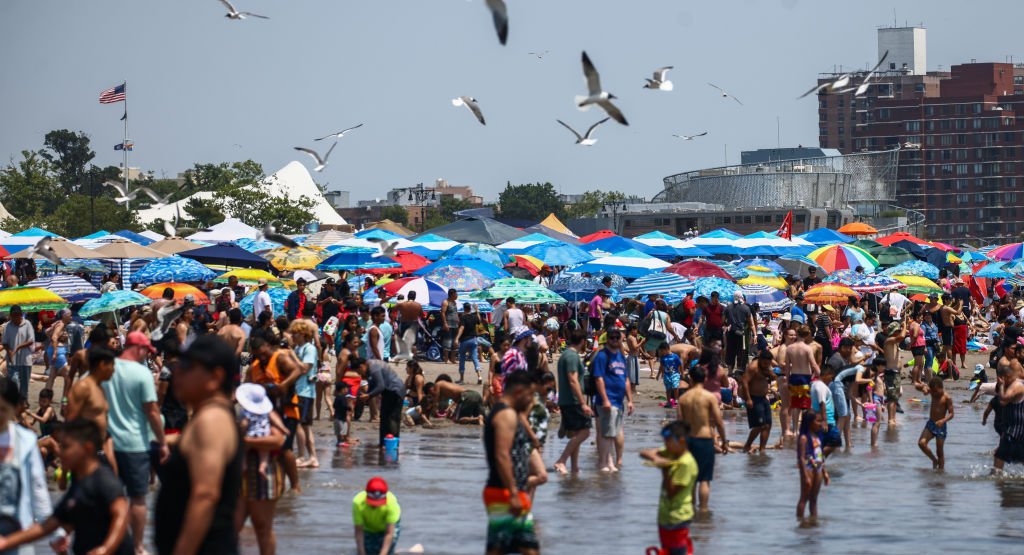New York City has activated its heat emergency plan for a record 21 days so far this summer, and by Monday, the number is likely to rise to 24, emergency management officials said on Friday.
Heat emergencies are defined as two consecutive days with a heat index, or real-feel temperature, of 95 degrees or higher, or one day with a heat index of at least 100 degrees, according to the city’s Emergency Management agency. Designated heat emergencies initiate a checklist of procedures, including issuing public advisories, monitoring hospitals and utility companies, trying to get homeless people off the streets, and opening cooling centers at libraries, community centers and other sites.
The aim is to protect New Yorkers from high temperatures and the cumulative effects of heat, said Emergency Management Commissioner Zachary Iscol.
“Heat puts stress on people’s bodies and especially if you are vulnerable,” Iscol said in a phone interview. “If you have preexisting conditions, you could still be in danger after the temperatures come down a bit.”
City officials said the threshold for what defines a heat emergency was last changed in 2008, so the record number of heat emergencies this season is due to more frequent, hotter days, which are driven by climate change. The current heat emergency in effect is expected to last through Monday, as temperatures and humidity levels remain high over the weekend.
With more than a month of summer still ahead, the city has already had four heat waves reaching real-feel temperatures of 100 degrees, according to city data. The summers of 2023 and 2022 recorded two heat waves each. Last year was the hottest year on record, according to the National Oceanic and Atmospheric Administration.
More New Yorkers are also getting sick from the heat.
So far this summer, there have been 13 days where more than 20 people were admitted to local emergency rooms for heat-related illness, city data shows. That’s compared to four such days in all of 2023 and 10 in all of 2022.
Graphs showing the maximum daily heat index and heat-related illness emergency room visits in New York City from May to August 2024
New York City government
City health officials did not comment on the heat emergency record on Friday, but a spokesperson for the health department pointed to remarks that Health Commissioner Ashwin Vasan made at a press conference last month, where he underscored the importance of the heat emergency plan.
“Over 300 New Yorkers die every year from heat-related deaths. Every single one of those is preventable,” Vasan said. “Over 400 New Yorkers end up in our emergency rooms and hospitals due to complications of elevated temperatures.”
The city’s heat emergencies date back to 1995, after a historic heat wave in Chicago killed more than 500 people. The first director of Emergency Management, Jerome Hauer, launched the heat emergency plan. Over time, it has become more calibrated toward protecting vulnerable populations, including older people and communities of color.
Two years ago, Emergency Management asked the National Weather Service to lower the bar for what qualifies as a heat advisory, according to Bill Goodman, a meteorologist with NWS.
“If you go farther south, the criteria remains pretty much the same,” he said. “Heat-related warnings vary from city to city. It tries to take into account the population.”
A graph showing the number of heat-related illness emergency room visits in New York City by year.
New York City government
Goodman said the city’s heat island effect, where the built environment results in higher temperatures, plays a factor in the adjustment. A recent study by the nonprofit Climate Central found that temperatures in New York City were almost 10 degrees hotter for the average resident because of the urban heat island effect than they would be otherwise — the biggest per capita temperature increase in all 65 cities studied.
As the realities of climate change become more direct for New Yorkers, Iscol said he envisions further modifications to the city’s heat emergency plan. He said he hopes it would include more federal funding for air conditioners for low-income groups and added that he wants to improve cooling centers.
“More free programming so that people have places of interest to go, like movie theaters, museums and other places, while they are escaping the heat,” he said.
